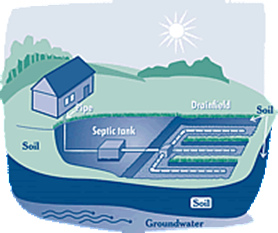 Onsite wastewater systems are multi-stage systems that collect, treat, and disperse wastewater generated by a home or business. The wastewater is treated and discharged to the soils rather than collected and transported to a wastewater treatment plant. The typical onsite wastewater system consists of a septic tank and some kind of leachfield to disperse the wastewater into the ground.
Onsite wastewater systems are multi-stage systems that collect, treat, and disperse wastewater generated by a home or business. The wastewater is treated and discharged to the soils rather than collected and transported to a wastewater treatment plant. The typical onsite wastewater system consists of a septic tank and some kind of leachfield to disperse the wastewater into the ground.
The first point of treatment of a wastewater system is the SEPTIC TANK that is a buried, watertight container usually made of concrete, fiberglass or polyethylene. Its job is to hold the wastewater long enough for solids to settle to the bottom (forming sludge) and for the oil and grease to float to the top (as scum). The tank should have an EFFLUENT FILTER at the outlet to keep solids from leaving the tank and clogging the leachfield.
Many systems include a DISTRIBUTION BOX that splits the flows from the septic tank into multiple leach lines in the dispersal system.;
The dispersal system or LEACHFIELD can be completely below the natural grade and consist of an absorption bed or trenches, be placed at-grade, or be a mound. Further treatment of the wastewater occurs as it flows into and through the soils.
If the leachfield is uphill of the septic tank, or if an at-grade or mound system is constructed, there typically will be a PUMP TANK to dose or pressurize the dispersal system.
There may be an advanced treatment system included with your system. They are called INNOVATIVE/ALTERNATIVE (I/A) systems and typically follow or replace the septic tank. These systems can treat the wastewater that allows for a smaller leachfield and reduced separations to groundwater tables and bedrock.
How Should You Maintain Your Onsite Wastewater System?
All of the components of an onsite wastewater system should be maintained on a regular basis. Septic tanks should be checked and pumped when the solids or scum reach a certain volume of the tank. Septic tank effluent filters should be checked and cleaned on a regular basis (either once or twice a year for most households and filters). Distribution boxes should be checked and adjusted to maintain equal distribution. Pump tanks should be checked for solids build-up and control panel operation (including checking the alarm). I/A systems typically require that a Maintenance Contract be in place between the homeowner and service provider. Depending on the I/A system, specific maintenance activities must be completed by the service provider.
How Should You Operate Your System?
 Use water efficiently – All of the water a household sends down its pipes winds up in its wastewater system. This means that the more water a household conserves, the less water enters the system. Efficient water use can improve the operation of a septic system and reduce the risk of failure.
Use water efficiently – All of the water a household sends down its pipes winds up in its wastewater system. This means that the more water a household conserves, the less water enters the system. Efficient water use can improve the operation of a septic system and reduce the risk of failure.
- High-efficiency toilets – high efficiency toilets use 1.28 gallons of water or less per flush. Replace older models as a quick way to reduce flows.
- Faucet aerators and high-efficiency showerheads – these both reduce the amount of water flowing through the piping thus reducing flows.
- Washing machines – Select the proper load size, run only full loads of laundry, stagger loads over the week
- Consider purchasing ENERGY STAR appliances or WaterSense labeled fixtures.
- Take care at the drain – Toilets and kitchen sinks aren’t trash cans!
- Toilets - An easy rule of thumb is don’t flush anything besides human waste and toilet paper. Never flush - feminine hygiene products, diapers, cigarette butts, coffee grounds, cat litter, household chemicals, pharmaceuticals.
- Sinks – Avoid chemical drain openers for clogged drains. Instead use boiling water or a drain snake. Never pour paints (including Latex), solvents, or large volumes of toxic cleaners down the drain. Eliminate or limit the use of a garbage disposal, which will significantly reduce the amount of solids entering the tank.
- Maintain your leachfield – Here are a few things you should do:
- Never park or drive on your leachfield.
- Plant trees the appropriate distance from your leachfield to keep roots from growing into your septic system
- Keep roof drains, sump pumps, and other rainwater drainage systems away from your leachfield
Failure Symptoms and Causes
- Failure Symptoms - Call a septic professional if you notice any of the following:
- Wastewater backing up into household drains.
- Bright green, spongy grass on the leachfield, even during dry weather.
- Pooling water or muddy soil around your wastewater system or in your basement.
- A strong odor around the septic tank and leachfield. (Sometimes odors can be detected from the plumbing vents. This may be a nuisance, but not always a sign of a malfunctioning system.)
- Failure Causes – Wastewater system failures may be caused by a number of activities including: pouring chemicals down sinks or toilets; excessive water use; failure to provide proper maintenance; emptying into the system hot tubs and spas; use of garbage disposals; and improper design or installation of the system. The leachfield may clog over time, so it may also be at the end of its useful life.
Resources:
Permit conditions and the importance of complying with permit conditions
U.S. EPA SepticSmart Website for Homeowners
Excellent 5-minute video on septic systems – “It’s All Connected”

